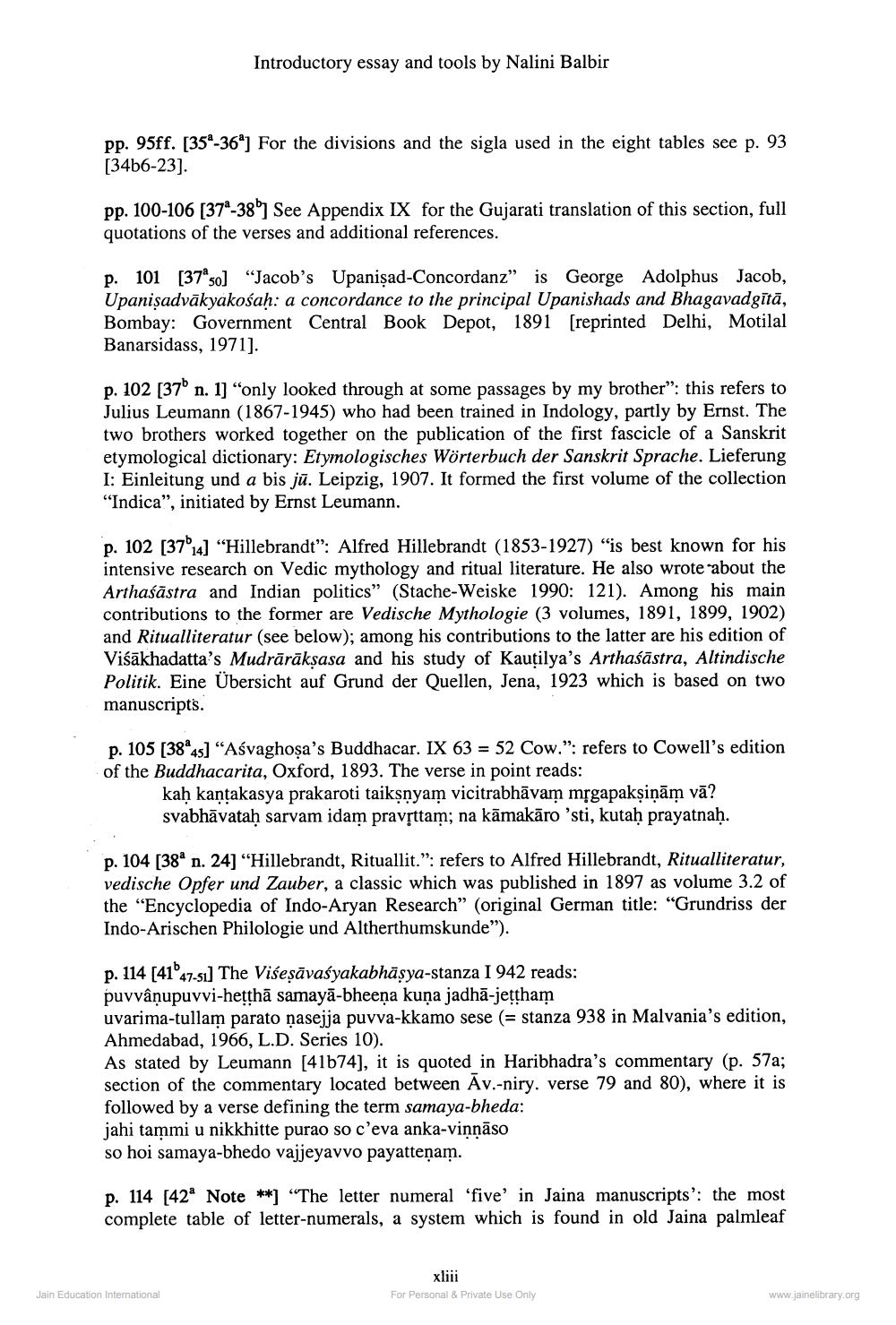________________
Introductory essay and tools by Nalini Balbir
pp. 95ff. [354-36] For the divisions and the sigla used in the eight tables see p. 93 [34b6-23].
pp. 100-106 [370-38] See Appendix IX for the Gujarati translation of this section, full quotations of the verses and additional references.
p. 101 [37°30] "Jacob's Upanisad-Concordanz" is George Adolphus Jacob, Upanisadvākyakośah: a concordance to the principal Upanishads and Bhagavadgītā, Bombay: Government Central Book Depot, 1891 [reprinted Delhi, Motilal Banarsidass, 1971).
p. 102 (37° n. 1] "only looked through at some passages by my brother”: this refers to Julius Leumann (1867-1945) who had been trained in Indology, partly by Ernst. The two brothers worked together on the publication of the first fascicle of a Sanskrit etymological dictionary: Etymologisches Wörterbuch der Sanskrit Sprache. Lieferung I: Einleitung und a bis jū. Leipzig, 1907. It formed the first volume of the collection "Indica", initiated by Ernst Leumann.
p. 102 (37o14] "Hillebrandt”: Alfred Hillebrandt (1853-1927) "is best known for his intensive research on Vedic mythology and ritual literature. He also wrote about the Arthaśāstra and Indian politics" (Stache-Weiske 1990: 121). Among his main contributions to the former are Vedische Mythologie (3 volumes, 1891, 1899, 1902) and Ritualliteratur (see below); among his contributions to the latter are his edition of Višākhadatta's Mudrārākṣasa and his study of Kautilya's Arthaśāstra, Altindische Politik. Eine Übersicht auf Grund der Quellen, Jena, 1923 which is based on two manuscripts.
p. 105 [38445] "Asvaghosa's Buddhacar. IX 63 = 52 Cow.": refers to Cowell's edition of the Buddhacarita, Oxford, 1893. The verse in point reads:
kaḥ kantakasya prakaroti taiksnyam vicitrabhāvam mțgapakşiņām vā? svabhāvataḥ sarvam idam pravsttam; na kāmakāro 'sti, kutah prayatnaḥ.
p. 104 [389 n. 24] “Hillebrandt, Rituallit.”: refers to Alfred Hillebrandt, Ritualliteratur, vedische Opfer und Zauber, a classic which was published in 1897 as volume 3.2 of the “Encyclopedia of Indo-Aryan Research” (original German title: "Grundriss der Indo-Arischen Philologie und Altherthumskunde").
p. 114 [41047-51] The Višeşāvasyakabhāşya-stanza I 942 reads: puvvânupuvvi-hetthā samayā-bheeņa kuna jadhā-jettham uvarima-tullam parato nasejja puvva-kkamo sese (= stanza 938 in Malvania's edition, Ahmedabad, 1966, L.D. Series 10). As stated by Leumann [41b74), it is quoted in Haribhadra's commentary (p. 57a; section of the commentary located between Av.-niry. verse 79 and 80), where it is followed by a verse defining the term samaya-bheda: jahi tammi u nikkhitte purao so c'eva anka-viņņāso so hoi samaya-bhedo vajjeyavvo payatteņam.
p. 114 [42“ Note **) “The letter numeral 'five' in Jaina manuscripts': the most complete table of letter-numerals, a system which is found in old Jaina palmleaf
xliii For Personal & Private Use Only
Jain Education International
www.jainelibrary.org




